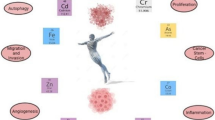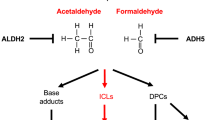Abstract
Purpose
Genetic polymorphisms in DNA repair genes and hair dye use may both have a role in the development of non-Hodgkin lymphoma (NHL). We aimed to examine the interaction between variants in DNA repair genes and hair dye use with risk of NHL in a population-based case–control study of Connecticut women.
Methods
We examined 24 single nucleotide polymorphisms in 16 DNA repair genes among 518 NHL cases and 597 controls and evaluated the associations between hair dye use and risk of overall NHL and common NHL subtypes, stratified by genotype, using unconditional logistic regression.
Results
Women who used hair dye before 1980 had a significantly increased risk of NHL, particularly for the follicular lymphoma (FL) subtype, but not for diffuse large B-cell lymphoma. The following genotypes in combination with hair dye use before 1980 were associated with FL risk: BRCA2 rs144848 AC+CC [odds ratio (OR) (95 % confidence interval (CI)) 3.28(1.27–8.50)], WRN rs1346044 TT [OR(95 % CI) 2.70(1.30–5.65)], XRCC3 rs861539 CT+TT [OR(95 % CI) 2.76(1.32–5.77)], XRCC4 rs1805377 GG [OR(95 % CI) 2.07(1.10–3.90)] and rs1056503 TT [OR(95 % CI) 2.17(1.16–4.07)], ERCC1 rs3212961 CC [OR(95 % CI) 1.93(1.00–3.72)], RAD23B rs1805329 CC [OR(95 % CI) 2.28(1.12–4.64)], and MGMT rs12917 CC, rs2308321 AA, and rs2308327 AA genotypes [OR(95 % CI) 1.96(1.06–3.63), 2.02(1.09–3.75), and 2.23(1.16–4.29), respectively]. In addition, a significant interaction with risk of overall NHL was observed between WRN rs1346044 and hair dye use before 1980 (p interaction = 0.032).
Conclusions
Our results indicated that genetic variation in DNA repair genes modifies susceptibility to NHL in relation to hair dye use, particularly for the FL subtype and in women who began using hair dye before 1980. Further studies are needed to confirm these observations.
Similar content being viewed by others
Abbreviations
- NHL:
-
Non-Hodgkin lymphoma
- DLBCL:
-
Diffuse large B-cell lymphoma
- FL:
-
Follicular lymphoma
- MAF:
-
Minor allele frequency
- CI:
-
Confidence interval
References
Muller AM, Ihorst G, Mertelsmann R, Engelhardt M (2005) Epidemiology of non-Hodgkin’s lymphoma (NHL): trends, geographic distribution, and etiology. Ann Hematol 84(1):1–12. doi:10.1007/s00277-004-0939-7
Ekstrom-Smedby K (2006) Epidemiology and etiology of non-Hodgkin lymphoma—a review. Acta Oncol 45(3):258–271. doi:10.1080/02841860500531682
Bassig BA, Lan Q, Rothman N, Zhang Y, Zheng T (2012) Current understanding of lifestyle and environmental factors and risk of non-hodgkin lymphoma: an epidemiological update. J Cancer Epidemiol (978930. doi:10.1155/2012/978930
de Sanjose S, Benavente Y, Nieters A, Foretova L, Maynadie M, Cocco PL, Staines A, Vornanen M, Boffetta P, Becker N, Alvaro T, Brennan P (2006) Association between personal use of hair dyes and lymphoid neoplasms in Europe. Am J Epidemiol 164(1):47–55. doi:10.1093/aje/kwj187
Takkouche B, Etminan M, Montes-Martinez A (2005) Personal use of hair dyes and risk of cancer: a meta-analysis. JAMA 293(20):2516–2525. doi:10.1001/jama.293.20.2516
Zhang Y, Sanjose SD, Bracci PM, Morton LM, Wang R, Brennan P, Hartge P, Boffetta P, Becker N, Maynadie M, Foretova L, Cocco P, Staines A, Holford T, Holly EA, Nieters A, Benavente Y, Bernstein L, Zahm SH, Zheng T (2008) Personal use of hair dye and the risk of certain subtypes of non-Hodgkin lymphoma. Am J Epidemiol 167(11):1321–1331. doi:10.1093/aje/kwn058
Zhang Y, Holford TR, Leaderer B, Boyle P, Zahm SH, Flynn S, Tallini G, Owens PH, Zheng T (2004) Hair-coloring product use and risk of non-Hodgkin’s lymphoma: a population-based case–control study in Connecticut. Am J Epidemiol 159(2):148–154
Sangrajrang S, Renard H, Kuhaprema T, Pornsopone P, Arpornwirat W, Brennan P (2011) Personal use of hair dyes—increased risk of non-Hodgkin’s lymphoma in Thailand. Asian Pac J Cancer Prev 12(9):2393–2396
Preston RJ, Skare JA, Aardema MJ (2010) A review of biomonitoring studies measuring genotoxicity in humans exposed to hair dyes. Mutagenesis 25(1):17–23. doi:10.1093/mutage/gep044
Huang YC, Hung WC, Kang WY, Chen WT, Chai CY (2007) p-Phenylenediamine induced DNA damage in SV-40 immortalized human uroepithelial cells and expression of mutant p53 and COX-2 proteins. Toxicol Lett 170(2):116–123. doi:10.1016/j.toxlet.2007.02.011
Ames BN, Kammen HO, Yamasaki E (1975) Hair dyes are mutagenic: identification of a variety of mutagenic ingredients. Proc Natl Acad Sci USA 72(6):2423–2427
Sontag JM (1981) Carcinogenicity of substituted-benzenediamines (phenylenediamines) in rats and mice. J Natl Cancer Inst 66(3):591–602
Zhang Y, Hughes KJ, Zahm SH, Holford TR, Dai L, Bai Y, Han X, Qin Q, Lan Q, Rothman N, Zhu Y, Leaderer B, Zheng T (2009) Genetic variations in xenobiotic metabolic pathway genes, personal hair dye use, and risk of non-Hodgkin lymphoma. Am J Epidemiol 170(10):1222–1230. doi:10.1093/aje/kwp263
Palitti F (2004) Mechanisms of formation of chromosomal aberrations: insights from studies with DNA repair-deficient cells. Cytogenet Genome Res 104(1–4):95–99. doi:10.1159/000077471
Shen M, Zheng T, Lan Q, Zhang Y, Zahm SH, Wang SS, Holford TR, Leaderer B, Yeager M, Welch R, Kang D, Boyle P, Zhang B, Zou K, Zhu Y, Chanock S, Rothman N (2006) Polymorphisms in DNA repair genes and risk of non-Hodgkin lymphoma among women in Connecticut. Hum Genet 119(6):659–668. doi:10.1007/s00439-006-0177-2
Barry KH, Zhang Y, Lan Q, Zahm SH, Holford TR, Leaderer B, Boyle P, Hosgood HD 3rd, Chanock S, Yeager M, Rothman N, Zheng T (2011) Genetic variation in metabolic genes, occupational solvent exposure, and risk of non-hodgkin lymphoma. Am J Epidemiol 173(4):404–413. doi:10.1093/aje/kwq360
Jaffe ES, Stein H, Vardiman JW (2001) World Health Organization classification of tumors: pathology and genetics of tumors of haematopoietic and lymphoid tissues. IARC Press, Lyon
Garcia-Closas M, Egan KM, Abruzzo J, Newcomb PA, Titus-Ernstoff L, Franklin T, Bender PK, Beck JC, Le Marchand L, Lum A, Alavanja M, Hayes RB, Rutter J, Buetow K, Brinton LA, Rothman N (2001) Collection of genomic DNA from adults in epidemiological studies by buccal cytobrush and mouthwash. Cancer Epidemiol Biomarkers Prev 10(6):687–696
Packer BR, Yeager M, Staats B, Welch R, Crenshaw A, Kiley M, Eckert A, Beerman M, Miller E, Bergen A, Rothman N, Strausberg R, Chanock SJ (2004) SNP500Cancer: a public resource for sequence validation and assay development for genetic variation in candidate genes. Nucleic Acids Res 32(Database issue):D528–D532. doi:10.1093/nar/gkh005
Benjamini Y, Hochberg Y (1995) Controlling the false discovery rate: a practical and powerful approach to multiple testing. J R Stat Soc B 57(1):289–300
Morton LM, Bernstein L, Wang SS, Hein DW, Rothman N, Colt JS, Davis S, Cerhan JR, Severson RK, Welch R, Hartge P, Zahm SH (2007) Hair dye use, genetic variation in N-acetyltransferase 1 (NAT1) and 2 (NAT2), and risk of non-Hodgkin lymphoma. Carcinogenesis 28(8):1759–1764. doi:10.1093/carcin/bgm121
Corbett JF (1999) An historical review of the use of dye precursors in the formulation of commercial oxidation hair dyes. Dyes Pigments 41(1–2):127–136
Damerla RR, Knickelbein KE, Strutt S, Liu FJ, Wang H, Opresko PL (2012) Werner syndrome protein suppresses the formation of large deletions during the replication of human telomeric sequences. Cell Cycle 11(16):3036–3044. doi:10.4161/cc.21399
Maddukuri L, Ketkar A, Eddy S, Zafar MK, Griffin WC, Eoff RL (2012) Enhancement of human DNA polymerase eta activity and fidelity is dependent upon a bipartite interaction with the Werner syndrome protein. J Biol Chem 287(50):42312–42323. doi:10.1074/jbc.M112.410332
Sakamoto S, Nishikawa K, Heo SJ, Goto M, Furuichi Y, Shimamoto A (2001) Werner helicase relocates into nuclear foci in response to DNA damaging agents and co-localizes with RPA and Rad51. Genes Cells 6(5):421–430
Gee J, Ding Q, Keller JN (2002) Analysis of Werner’s expression within the brain and primary neuronal culture. Brain Res 940(1–2):44–48
Brenneman MA, Weiss AE, Nickoloff JA, Chen DJ (2000) XRCC3 is required for efficient repair of chromosome breaks by homologous recombination. Mutat Res 459(2):89–97
Mari PO, Florea BI, Persengiev SP, Verkaik NS, Bruggenwirth HT, Modesti M, Giglia-Mari G, Bezstarosti K, Demmers JA, Luider TM, Houtsmuller AB, van Gent DC (2006) Dynamic assembly of end-joining complexes requires interaction between Ku70/80 and XRCC4. Proc Natl Acad Sci USA 103(49):18597–18602. doi:10.1073/pnas.0609061103
He XF, Wei W, Li JL, Shen XL, Ding DP, Wang SL, Liu ZZ, Qin JB, Wu LX, Xie DL (2013) Association between the XRCC3 T241M polymorphism and risk of cancer: evidence from 157 case–control studies. Gene 523(1):10–19. doi:10.1016/j.gene.2013.03.071
Lee PH, Shatkay H (2008) F-SNP: computationally predicted functional SNPs for disease association studies. Nucleic Acids Res 36:D820–D824. doi:10.1093/nar/gkm904
Inoue R, Abe M, Nakabeppu Y, Sekiguchi M, Mori T, Suzuki T (2000) Characterization of human polymorphic DNA repair methyltransferase. Pharmacogenetics 10(1):59–66
Jiao J, Zheng T, Lan Q, Chen Y, Deng Q, Bi X, Kim C, Holford T, Leaderer B, Boyle P, Ba Y, Xia Z, Chanock SJ, Rothman N, Zhang Y (2012) Occupational solvent exposure, genetic variation of DNA repair genes, and the risk of non-Hodgkin’s lymphoma. Eur J Cancer Prev 21(6):580–584. doi:10.1097/CEJ.0b013e328351c762
Morton LM, Wang SS, Cozen W, Linet MS, Chatterjee N, Davis S, Severson RK, Colt JS, Vasef MA, Rothman N, Blair A, Bernstein L, Cross AJ, De Roos AJ, Engels EA, Hein DW, Hill DA, Kelemen LE, Lim U, Lynch CF, Schenk M, Wacholder S, Ward MH, Hoar Zahm S, Chanock SJ, Cerhan JR, Hartge P (2008) Etiologic heterogeneity among non-Hodgkin lymphoma subtypes. Blood 112(13):5150–5160. doi:10.1182/blood-2008-01-133587
Acknowledgments
This work was partly supported by National Cancer Institute grant CA62006 (Connecticut Women’s NHL Study, Yale University) and by Fogarty training grants D43TW 008323 and D43TW 007864-01 from the National Institutes of Health (T. Zheng). Certain data used in this study were obtained from the Connecticut Tumor Registry located in the Connecticut Department of Public Health. The author(s) assume(s) full responsibility for analyses and interpretation of these data. The cooperation of 28 Connecticut hospitals, including Charlotte Hungerford Hospital, Bridgeport Hospital, Danbury Hospital, Hartford Hospital, Middlesex Hospital, New Britain General Hospital, Bradley Memorial Hospital, Yale/New Haven Hospital, St. Francis Hospital and Medical Center, St. Mary’s Hospital, Hospital of St. Raphael, St. Vincent’s Medical Center, Stamford Hospital, William W. Backus Hospital, Windham Hospital, Eastern Connecticut Health Network, Griffin Hospital, Bristol Hospital, Johnson Memorial Hospital, Day Kimball Hospital, Greenwich Hospital, Lawrence and Memorial Hospital, Milford Hospital, New Milford Hospital, Norwalk Hospital, MidState Medical Center, John Dempsey Hospital, and Waterbury Hospital, in allowing patient access, is gratefully acknowledged.
Conflict of interest
The authors declared no potential competing financial interests.
Author information
Authors and Affiliations
Corresponding author
Electronic supplementary material
Below is the link to the electronic supplementary material.
Rights and permissions
About this article
Cite this article
Guo, H., Bassig, B.A., Lan, Q. et al. Polymorphisms in DNA repair genes, hair dye use, and the risk of non-Hodgkin lymphoma. Cancer Causes Control 25, 1261–1270 (2014). https://doi.org/10.1007/s10552-014-0423-1
Received:
Accepted:
Published:
Issue Date:
DOI: https://doi.org/10.1007/s10552-014-0423-1




